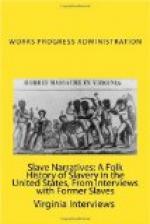“When they arrived about four miles east of Brazil, or what was known as Harmony, the train was stopped and a crowd of white miners ordered them not to come any nearer Brazil. Then the trouble began. Our men did not know of the labor trouble, as they were not told of that part. Here they were fifteen hundred miles from home, no money. It was terrible. Many walked back to Virginia. Some went on foot to Illinois. Mr. Masten took some of them South of Brazil about three miles, where he had a number of company houses, and they tried to work in his mine there. But many were shot at from the bushes and killed. Guards were placed about the mine by the owner, but still there was trouble all the time. The men did not make what Mr. Masten told them they could make, yet they had to stay for they had no place to go. After about six months, my husband who had been working in that mine, fell into the shaft and was injured. He was unable to work for over a year. I came with my two children to take care of him. We had only a little furniture, slept in what was called box beds. I walked to Brazil each morning and worked at whatever I could get to do. Often did three washings a day and then walked home each evening, a distance of two miles, and got a dollar a day.
“Many of the white folks I worked for were well to do and often I would ask the Mistress for small amounts of food which they would throw out if left over from a meal. They did not know what a hard time we were having, but they told me to take home any of such food that I cared to. I was sure glad to get it, for it helped to feed our family. Often the white folks would give me other articles which I appreciated. I managed in this way to get the children enough to eat and later when my husband was able to work, we got along very well, and were thankful. After the strike was settled, things were better. My husband was not afraid to go out after dark. But the coal operators did not treat the colored folks very good. We had to trade at the Company store and often pay a big price for it. But I worked hard and am still alive today, while all the others are gone, who lived around here about that time. There has sure been a change in the country. The country was almost a wilderness, and where my home is today, there were very few roads, just what we called a pig path through the woods. We used lots of corn meal, cooked beans and raised all the food we could during them days. But we had many white friends and sure was thankful for them. Here I am, and still thankful for the many friends I have.”




